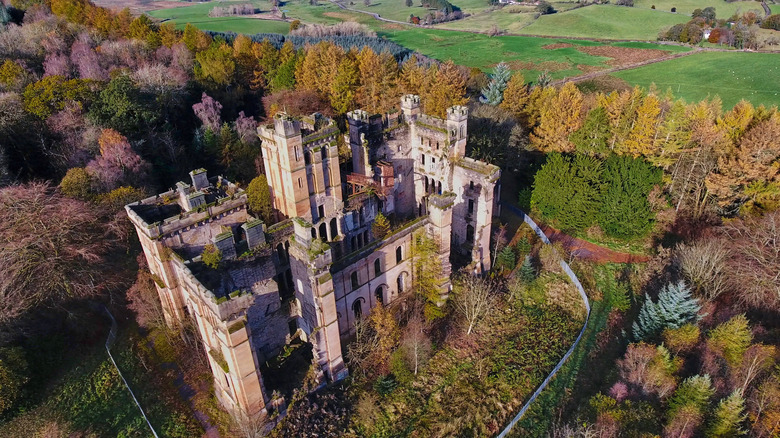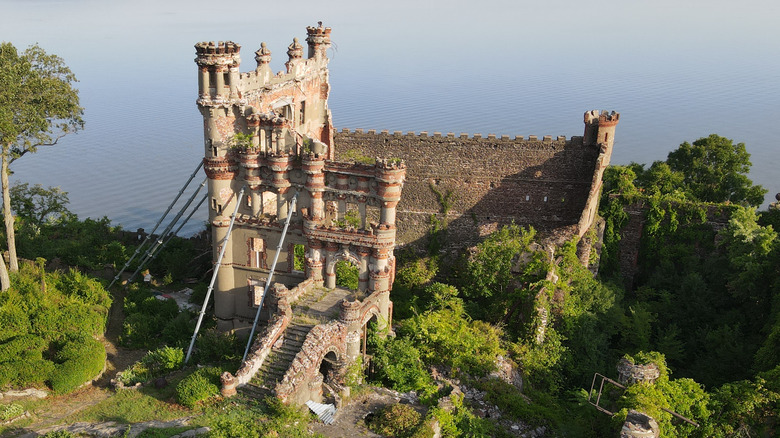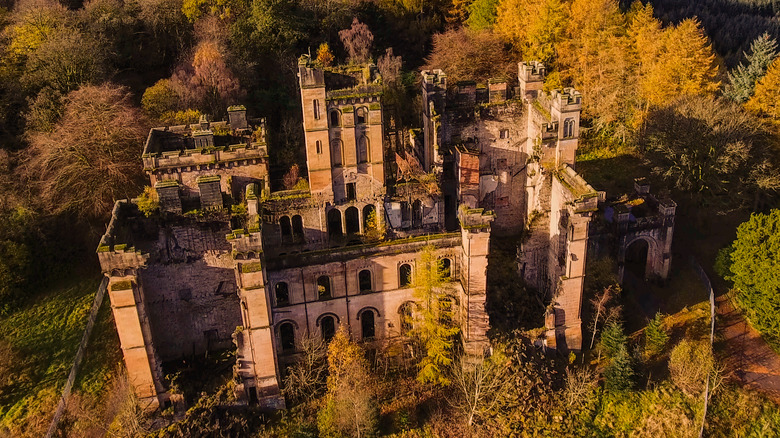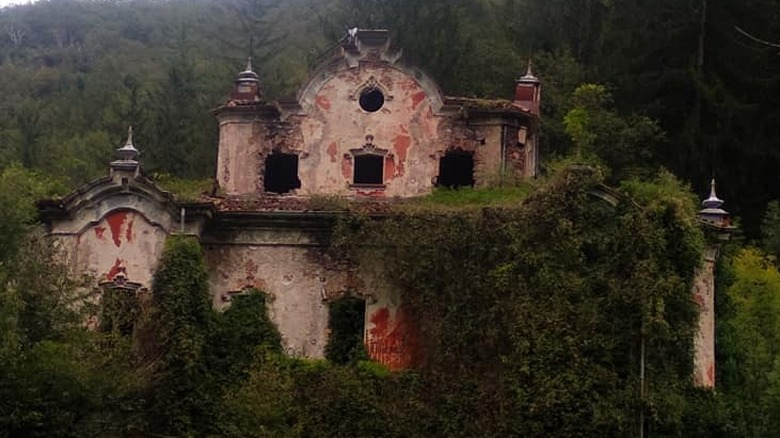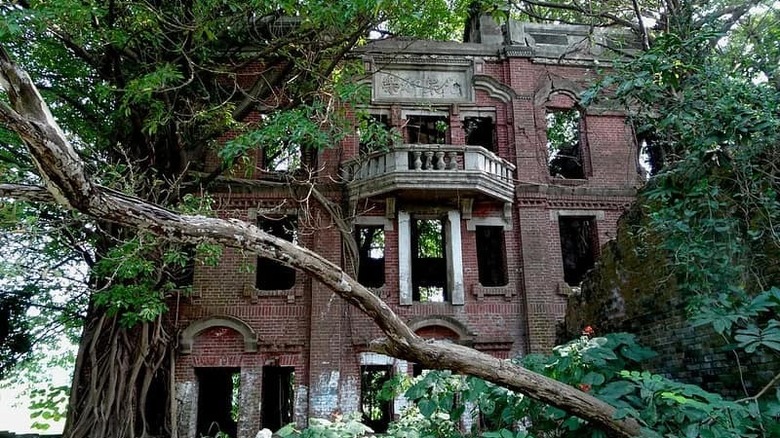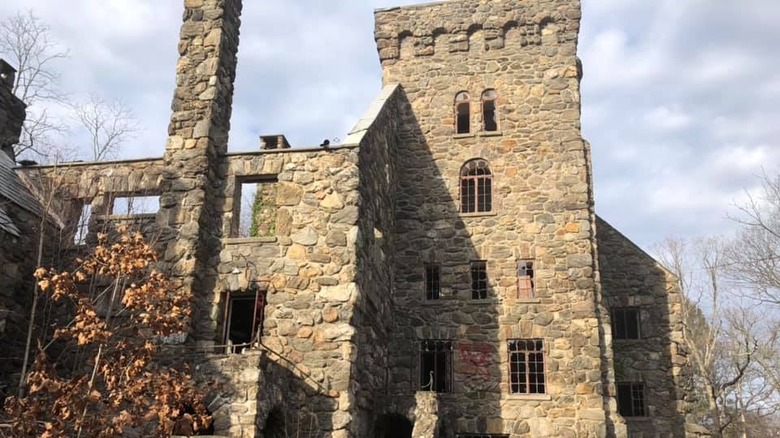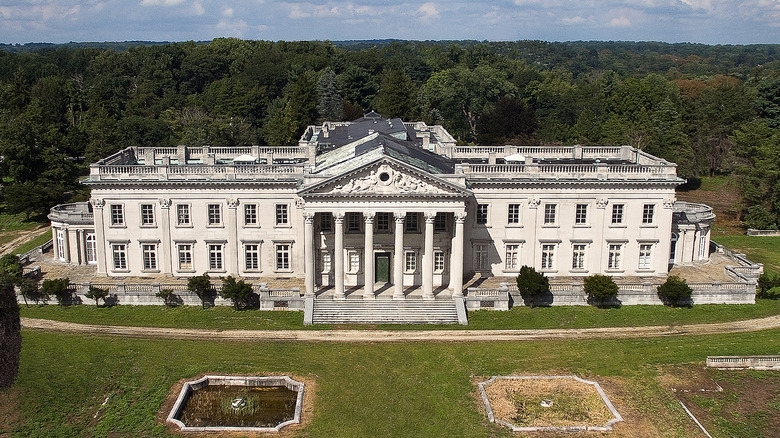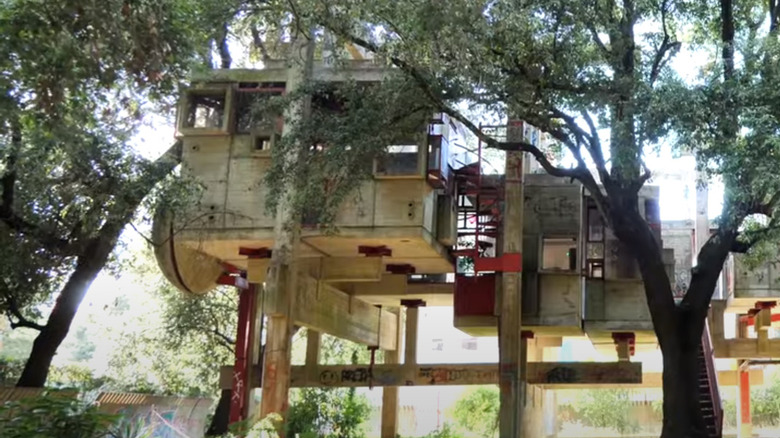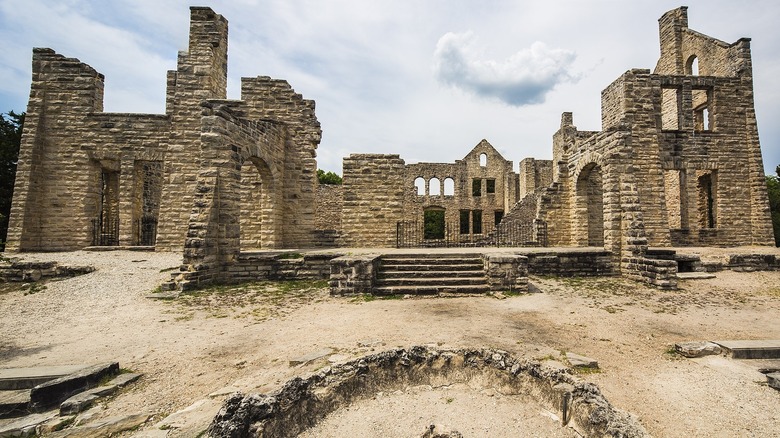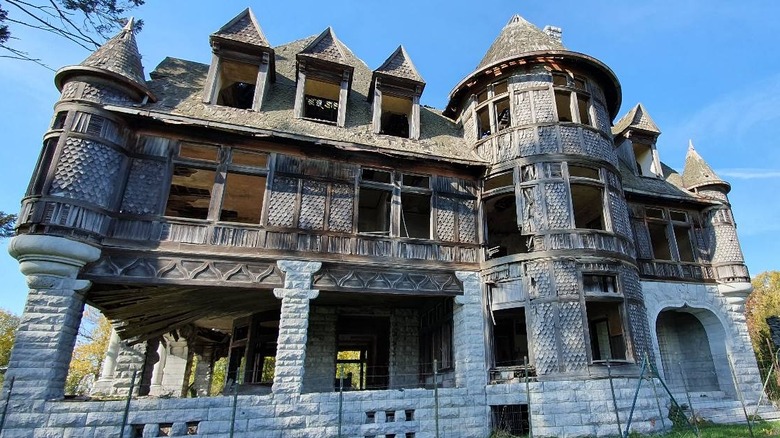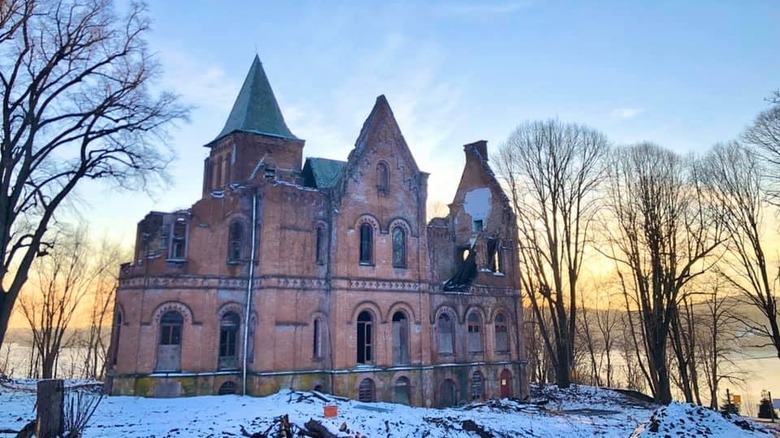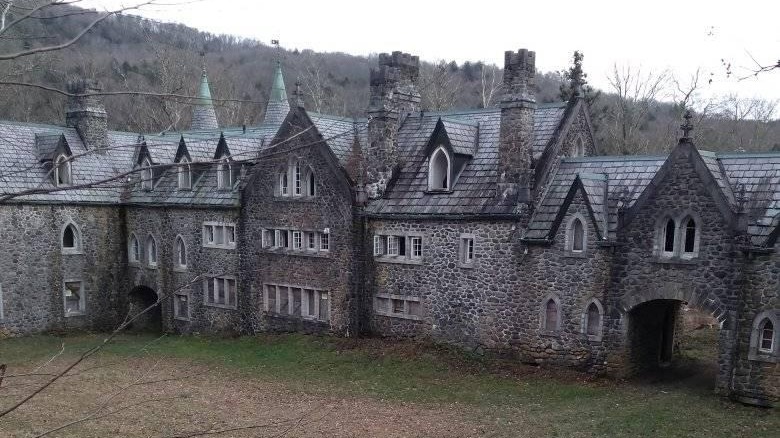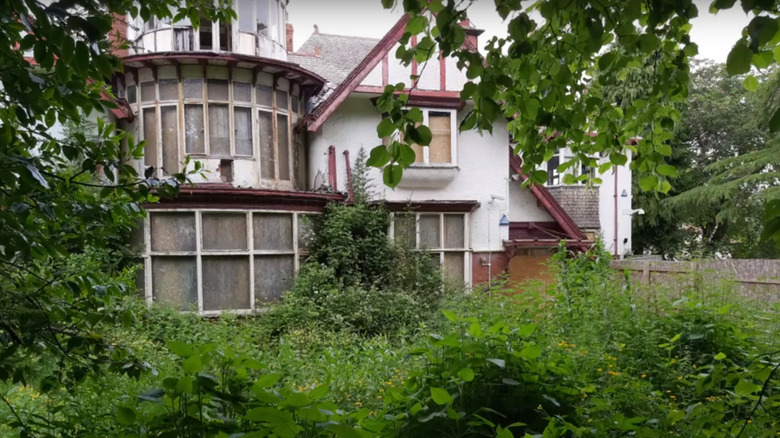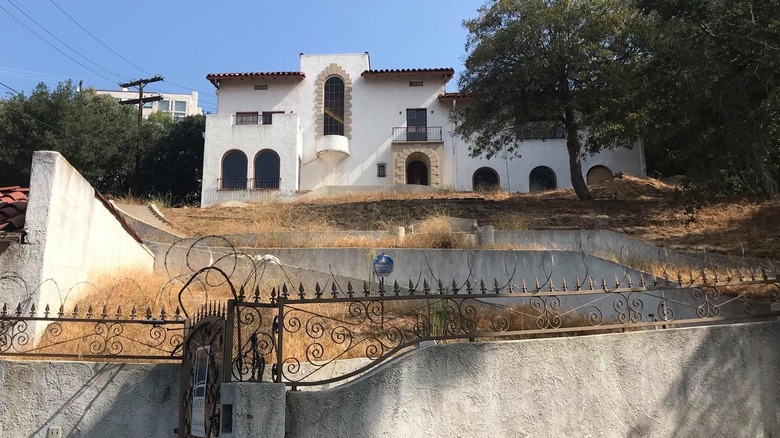Famous Properties That Have Actually Been Abandoned
To the average person, it seems unconscionable to abandon an exquisite, ornate mansion on acres of land that cost millions of dollars and at least several years to build — especially when it's so difficult to own a home, as noted by CNBC. But many people throughout history have done just that, whether it was because they were scared out by hauntings or because they simply had no one to pass the home to after their own deaths.
These days, some of these abandoned places welcome visitors with open arms, while others put up barbed wire and foreboding signage. To that end, whether you live in Camdentown, Missouri or Cortenova, Italy, there are tons of eerie abandoned homes right outside our doors that spark our imaginations with stories of hauntings, dilapidated interiors, and mysterious happenings. So if you're really feeling adventurous or even just a little bit curious, check out these abandoned homes from around the world.
Bannerman Castle, Beacon, New York
Take one look at the remnants of Bannerman Castle's formidable towers, seemingly endless walls, and stately façade, and it's easy to imagine castle builder and Scotsman Frank Bannerman VI calling this place home. However, it wasn't actually his home; Bannerman built the more than century-old castle as an arsenal for his gargantuan weapons collection, which soon needed castle-sized storage since his family business was the world's largest buyer of surplus military equipment, according to Historic Hudson River Towns.
After Bannerman's son spotted Hudson River's Pollopel Island, which is only about the size of five football fields, he got to work on his Scottish castle on the other side of the pond. But the dream was short-lived. A giant explosion obliterated the edifice in 1920, which only followed with years of neglect, recalled Curbed New York. Almost 50 years later, his family sold the castle to New York State, which had plans to use the entire island as a park. That didn't exactly work out, either.
Two years and just a few public tours later, a fire with an undetermined cause tore the castle apart and since then, the Taconic State Parks Commission has declared it off-limits. However, you can still get a front-row seat to its magnitude. The Bannerman Castle Trust Inc., in cooperation with the New York State Office of Parks, Recreation, and Historic Preservation, is now running tours of the castle and the island. All proceeds benefit preservation efforts.
Lennox Castle, Lennoxtown, Scotland
What's now ruins, crumbling brick, and overgrown greenery was once a lofty dream. When Glasgow Corporation purchased circa-1837 Lennox Castle (which also once served as a family mansion and a military hospital), it planned to convert it into the biggest and most modern psychiatric hospital of the time, according to Abandoned Spaces. That worked for almost 40 years, after the ribbon was cut at "Lennox Castle Certified Institution for Mental Defectives."
But conditions took a turn when funding began to wane to staff the 1,200 patients. The hospital's medical director said he had never worked in a "worse pit" and that he was "sick to the stomach about the plight of these poor people," reported The Scotsman. A 1989 British Medical Journal study revealed that 25% of patients were underweight and malnourished, recalled the Daily Record. And patients were forced to undergo harsh punishments, said Abandoned Spaces, such as having their diets restricted to bread and milk or having to run barefoot while being hit with baseball bats.
Finally, in the 1990s, patients were moved to better-equipped psychiatric hospitals and the hospital closed in 2002. After a demolition two years later, only the main, original building remained, but even that was ravaged by fire in 2008. Since then, the castle has remained empty and only continued to deteriorate, despite tentative plans to renovate.
Villa De Vecchi, Cortenova, Italy
Lake Como has long been an Italian resort destination, filled with million-euro homes and breathtaking views. There's also an elegant, empty mansion just an hour away, but there's a reason why it's been abandoned for more than 80 years: It's known as the most haunted house in Italy, according to House and History.
The summer home was built for Count Felix de Vecchi, head of the Italian National Guard, in the 1850s. The unique-appearing home featured both Baroque and Classical Eastern styles, as well as modern conveniences like indoor heating pipes and a huge fountain, reported Abandoned Playgrounds. But only a few years after its completion, tragedy struck when Count Felix came home to discover a brutal scene: His wife had been murdered and his daughter was missing. His search for his daughter remained unfounded and he committed suicide just months later, said Atlas Obscura, and the home was passed onto new owners until the 1960s. Since then, it's been abandoned -– by the living, at least.
Supposedly, music can still be heard from the now-smashed grand piano here. There are rumors of suicides, murders, and sacrifices that took place on the grounds. And even though an avalanche wiped out many of the nearby homes, it seems to have avoided Villa De Vecchi. However, the unstable land does make restoration unlikely.
If you or anyone you know is having suicidal thoughts, please call the National Suicide Prevention Lifeline at 1-800-273-TALK (8255).
Liu Family Mansion, New Taipei City, Taiwan
Why would the wealthy Liu family simply pack up and leave their colossal brick home in the 1950s, never to return? No one knows for sure, but judging by the theme of the theories that have floated about for decades, it probably involved ghosts, said Kathmandu and Beyond. It isn't also known as Minxiong Ghost House for nothing.
One of the most widely-shared myths is that family patriarch Liu Rong-yu had an affair with the maid. The maid, unable to cope with the community and family shame, committed suicide, but her spirit would not leave the Liu household. After one too many nights of hauntings, the Lius abandoned their three-story home for good.
Per the Taipei Times, other ghostly myths that explain the home's hauntings include the suicide of a Japanese soldier. Now, the home has been overtaken with vines and tree roots, which you can see up-close — and there doesn't seem to be any precautions taken by current owners to keep trespassers out, reported Kathmandu and Beyond.
If you or anyone you know is having suicidal thoughts, please call the National Suicide Prevention Lifeline at 1-800-273-TALK (8255).
Elda Castle, Ossining, New York
These days, abandoned Elda Castle doesn't have a lot in common with upscale Abercrombie and Fitch, a brand which led to the fortune of castle builders Mr. and Mrs. David Abercrombie, who built Elda Castle in 1927. It's named for the couple's four children: Elizabeth, Lucy, David, and Abbott Abercrombie, said Q107.
With 50 acres of land, 25 rooms, tons of courtyards and patios, and even a spiral staircase winding up a tower, Elda Castle was once a regal home for the Abercrombies. But when the family moved out, it turned out to be the beginning of the end. Several owners came and went, a few who attempted to renovate it. One family even sought to convert the castle into a retreat and conference center. Through those years, though, the castle was empty on-and-off, and in the meantime, vandals attacked the home, setting it on fire and pouring paint on the marble floors, per Pricey Pads.
More recently, Elda Castle was purchased by an investment firm which has yet to do anything with the enormous property, although they have put it on the market a few times. Instead, the castle continues to sit abandoned, filled with graffiti and disrepair.
Lynnewood Hall, Elkins Park, Pennsylvania
From afar, Lynnewood Hall looks like it could be the White House's sibling with its white façade and stately towers. But look closer and the damage to the 110-room abandoned mansion is all too clear.
About 120 years ago, Lynnewood Hall was built by Peter Arrell Browne Widener, who was also an investor in the Titanic, according to Love Property. Widener, who is known as one of the richest Americans in history, sought to build the property on a nearly 500-acre estate after his wife died and he wanted to start anew, far away from his Philadelphia townhouse filled with now-painful memories. He reportedly spent $8 million to build the 70,000-square-foot Lynnewood Hall. The Philadelphia Inquirer once said that the inside of the home was "dripping with silk, velvet, and gilded mouldings, the rooms furnished with chairs from Louis XV's palace, Persian rugs, and Chinese pottery, the halls crammed with art by Raphael, Rembrandt, and Donatello," recalled Icepop.
But 15 years later, Widener died, followed by the deaths of his son and grandson aboard the Titanic. Widener's only surviving child took over the estate, but after his death, neither of his children were interested in living there due to its immense expenses. It was then passed onto various owners through the years and in 2017, it was listed for $17.5 million, reported Curbed Philadelphia. However, an architect specializing in historic preservation revealed she would guess that Lynnewood Hall would need $50 million in repairs.
Casa Sperimentale, Fregene, Italy
At first glance, Casa Sperimentale doesn't appear as much of a home; it looks more like a 3-D puzzle hung in a tree, accompanied by a few enormous orbs. But it was a home for a family of Italian architects, who used the project as an opportunity to experiment with brutalist construction techniques, reported dezeen.
Over seven years starting in the 1960s, the Perugini family stacked geometric shapes atop one another to create a home about an hour outside of Rome. According to the Modern House, it never needed to actually be completed, either — the modular home was constructed with the intention to be modified whenever the Perugini family saw fit.
But when the owners died, Casa Sperimentale was abandoned and fell victim to both vandals and the elements. It's now covered in graffiti and it's clear that the structure is weakening — not a very promising sign for a house suspended in the air.
Ha Ha Tonkna Mansion, Camdenton, Missouri
A European castle seems pretty out of place in a Missouri state park. But it was Kansas City businessman Robert Snyder's fantasy to build Ha Ha Tonkna Mansion, named as such due to its home in Ha Ha Tonka State Park (which means "laughing waters," said Atlas Obscura).
Snyder bought 5,000 acres to build his dream mansion and got to work in 1905. Only a year later, though, he died in one of Missouri's first car crashes, according to Missouri State Parks. However, Snyder's sons took over the project and finally completed it almost two decades later. The glory was short-lived, though: Land lawsuits from property owners around the castle eventually drove one of the sons, who was residing in the castle, to run out of cash and move out.
Things seemed to be looking up when Ha Ha Tonkna Mansion was converted into a hotel and lodge but once again, tragedy struck: A fire engulfed the entire building in 1942, effectively destroying it. 30 years later, it was purchased by the state, which has tried to preserve the ruins of the once-grand castle. Although no one will likely ever live in Snyder's dream home again, Ha Ha Tonka State Park visitors can still see it for themselves, thanks to the state's work, reported Roadside America.
Wyckoff Villa, Thousand Islands, New York
Wyckoff Villa, also known as Carleton Villa, was built in 1895 for William Wyckoff, the president of Remington Arms and Typewriter Company. But the timing couldn't have been worse: About a month before the home's completion, Wyckoff's wife died, and he followed soon after. He died of a heart attack on the very night he moved in, according to Thousand Islands Life.
The colossal villa, designed by the same architect who worked on the design of Cornell University, according to Big Frog 104, was then passed onto Wyckoff's youngest son, Clarence Wyckoff. Until about 1927, it was a happy home, and then for unknown reasons it was left by its last occupant.
Since then — nearly a century ago — what was once the most jaw-dropping home in the Thousand Islands has sat empty. As with many abandoned homes, vandals have gotten around the fences and barbed wire and left murals of graffiti. But for the right buyer, there is hope for the dilapidated mansion. It's been on and off the market for years, including right now, as it's listed for nearly half a million dollars. However, it would cost millions to restore the home to its former glory.
Wyndclyffe Castle, Rhinebeck, New York
"Keeping up with Joneses" has long been a phrase to describe the rat race of climbing to the top. Unfortunately, though, the home that inspired the phrase wasn't able to do just that. Wyndclyffe Castle, a vacation home owned by socialite Elizabeth Schermerhorn Jones, is now an abandoned ghost of a mansion that was accessed for only $313,000, according to New York Upstate.
Jones, the aunt of novelist and Pulitzer Prize winner Edith Wharton who wrote classics such as "Ethan Frome," had the home built in 1853. At more than 7,500-square-feet, Wyndclyffe Castle had nine bedrooms, five bathrooms, and four fireplaces atop an 80-acre estate. But a century and a few various owners after Jones' death, the once-opulent mansion was abandoned. Now, it's covered in greenery and in complete disrepair, with entire sections of the home collapsed inwards, reported Town & Country.
Wyndclyffe Castle's future continues to be uncertain. It was sold at auction for $120,000 in 2016, and since then, there has not been any news on renovation or redevelopment by the current owners.
Dundas Castle, Roscoe, New York
When Ralph Wurts-Dundas purchased what is now known as Dundas Castle in the early 1900s, he had plans to convert the former 20-year-old lodge into a castle inspired by Dundas Castle in Scotland. But feeding into the rumors of the castle being cursed, he died right before it could be finished, according to Big Frog 104.
Neither of the other Dundas family members got to live in Dundas Castle, either, said Atlas Obscura. Just a year after Ralph's death, his wife, Josephine Wurts-Dundas, was committed to a sanitarium, who was later followed by their daughter. Afterwards, Dundas Castle — which is also known as Craig-E-Clair Castle, named by the original builder's wife — saw various owners and uses. It was a kids' summer camp and also a retreat for a Manhattan Masons group, which still owns the castle — or what's left of it — today. Since then, though, rumors of hauntings at the castle have circulated. Some say that the three property ponds fill with blood during a full moon, and since Josephine had been locked in a room here before she was committed, her own spirit now haunts the property.
Despite its supposed spooky activity and dismal atmosphere, though, Dundas Castle is currently being converted into a hotel, which should be finished by summer of 2022.
The Pineheath House, Harrogate, England
Most abandoned homes — especially ones that have been empty since 1986 — aren't full of photographs, dolls, and beddings, creating an eerie time machine into the past. The same can't be said for the Pineheath House, a 40-room mansion with an observation tower that was the vacation home of shipping magnate Sir Dhunjibhoy and Lady Bomanji, said the Mirror.
Since Lady Bomanji died in 1986 — nearly half a century after her husband — the Pineheath House has strangely sat untouched, unlike many other abandoned homes that are marked by graffiti and vandalism. Here, the beds are still made, keys are still in a drawer, and soap is still in the bathrooms.
According to the Daily Mail, the Pineheath House was purchased in 2013 by businessman Jason Shaw who had plans to restore the home. In 2020, the Harrogate Advertiser published news that Shaw had submitted a planning application to convert the Pineheath House into 16 luxury apartments. That will include restoring the cupola, demolishing the greenhouse, and extending the building to the rear, reported the Yorkshire Post. However, it's been a long road for Shaw, who has previously said he planned to sell the Pineheath House after his original planning application was denied.
The Los Feliz Murder House, Los Feliz, California
Los Feliz is a hip and modern neighborhood of Los Angeles, California. But there's a dark past at 2475 Glendower Place, the site where a cardiologist killed his wife with a ball-peen hammer and then attempted to do the same to his daughter, reported the New York Post. According to a podcast on the history of the so-called Los Feliz Murder House, the doctor, Dr. Harold Perelson, had a history of mental health issues. After the murder, he killed himself, and since then, the mansion has sat empty, according to Atlas Obscura.
But that doesn't mean that it has been without ownership. Only adding to the strangeness of the home, one couple bought it and used it as a storage site for many years, but never removed many of the Perelsons' personal effects. The new owner's son didn't remove them, either; the only change is that he installed an alarm system. He also never lived there — he only stopped by to feed his cats.
After the son's death, the 5,000-square-foot home went up for sale once again, according to Domain. The mansion was sold in October of 2020, but no plans on what the new owners plan to do with the property have been shared.
If you or someone you know is dealing with domestic abuse, you can call the National Domestic Violence Hotline at 1−800−799−7233. You can also find more information, resources, and support at their website.
